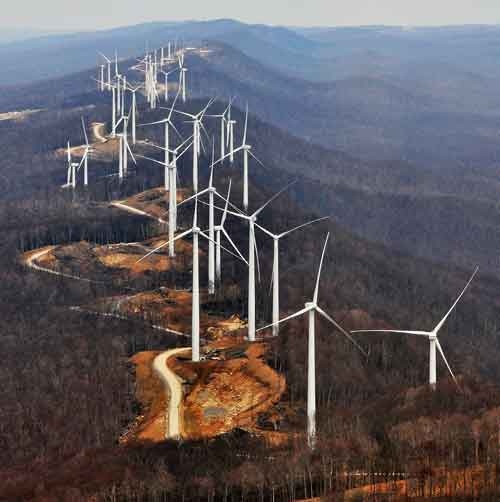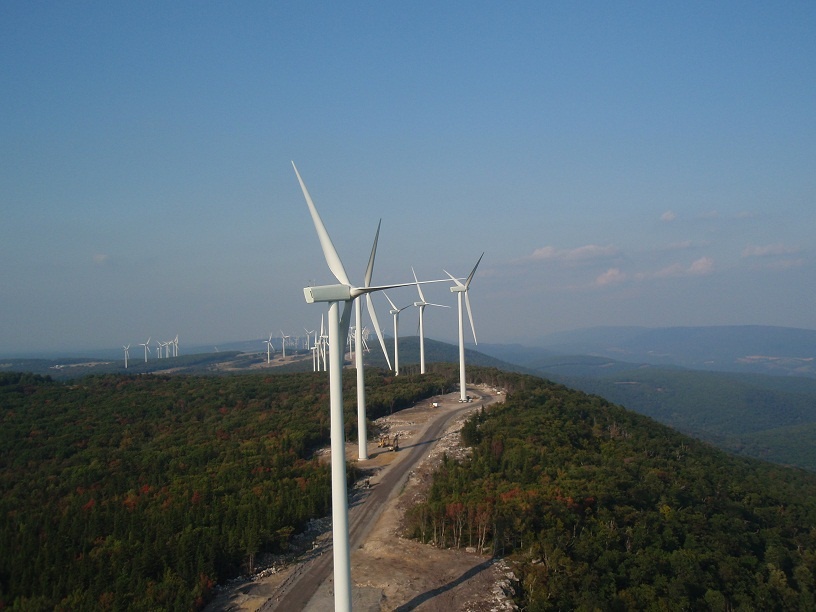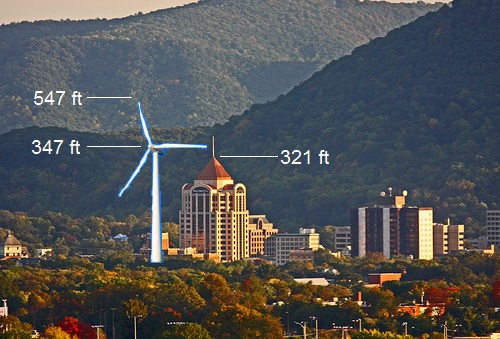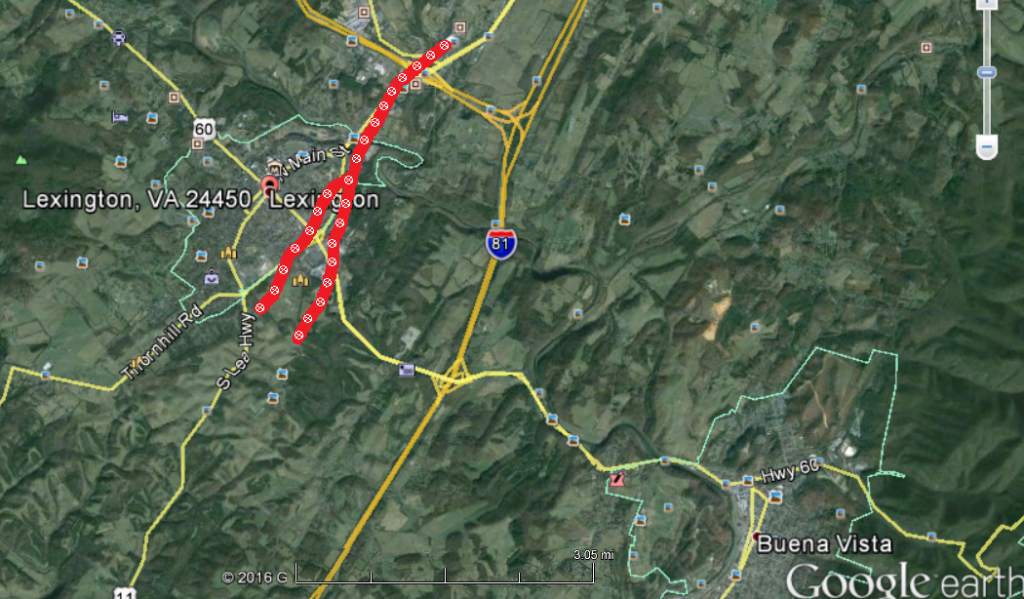IMPORTANT NEWS: The public comment period for Rocky Forge has ended. Apex must now produce a document containing all of the comments and their responses. When that document becomes available, we will post it on our site. Click here to view the application documents provided by Apex to the DEQ.
View Shed
The project is located in the Botetourt County Forest Conservation (FC) Use District. The purpose of the FC District is to preserve and enhance the natural appearance and function of the county’s ridges, valleys and forest lands, to maintain the high quality of air and water resources, and to maintain low density of development. A map illustrating the effect of the proposed project on the view shed was prepared by David Harbor on behalf of the Rockbridge Area Conservation Council. The map illustrates that turbines will be visible as far away as Augusta County, more than 35 miles from the project site. See the map: Turbine Visibility Map
Below are pictures from two industrial wind facilities in West Virginia. It is interesting to see these pictures since both facilitiess are located on the top of mountain ridges just like the proposed rocky Forge Wind project. In the Laurel Mountain wind facility the tower heights are 262 feet, with total height to the tip of the blade being 388 feet. In the Storm Mountain wind farm, the tower heights are 256 feet, with total height to the tip of the blade being about 380 feet. These are significantly shorter than the turbines proposed for Rocky Forge having a total height to the tip of the blade being 547 feet, so you can imagine how large the Rocky Forge turbines will appear on the top of North Mountain.
Laurel Mountain Wind Farm, West Virginia
Mount Storm Wind Farm, West Virginia
To put their size in perspective the picture below superimposes a turbine of the size being proposed for Rocky Forge next to the Wells Fargo Tower in Roanoke, the tallest building in the area:
With respect to the size of the site where these 25 turbines will be built, the proposed layout is superimposed on a Google Map of Lexington. As can be seen, the turbine site (shown in red, with white circles indicating turbine placement) is an “inverted Y” that is 3 miles long. If this were built in Lexington, it would extend from the south side of Lexington at the intersection of south Main and the U.S. 11 Bypass, and extend all the way to WalMart on U.S. 11 north:
Moores Creek State Forest, the Lexington Reservoir, Jefferson National Forest, George Washington National Forest, multiple Conservation Easements in Rockbridge County and Botetourt County are located within 5 miles of the project area. The project will impact the view shed of these areas. In addition, Short Hills Wildlife Management Area will also have view shed impacts. The project will impact view sheds for citizens from all magisterial areas of Rockbridge County. The following links are to maps with view shed analysis for Rockbridge County that were prepared for the Rockbridge Area Conservation Council (RACC):
Wind Turbine Visibility for Rockbridge County
Wind Turbine Visibility for Southern Rockbridge County
The proposed project violates the specific recommendations put forth in the VA Outdoor Plan for Region 5 to develop ridgeline ordinances to preserve open space and recreational lands, to protect the view shed for the National Park Service’s Blue Ridge Parkway, and to protect the view shed for the National Scenic Appalachian Trail. It also violates specific recommendations to protect scenic river view sheds and potential scenic river view sheds for the Upper James River Heritage Trail’s designated Blueway, and for recommended scenic byways along the James River and in Botetourt County.
This is a devastating blow to the economic viability of a region that depends on the natural beauty of its heritage mountain ridges to bring tourists into the area.
Light Pollution
Wind turbines are intentionally high contrast against background sky conditions. FAA requires that wind turbines be painted white or very light grey, as these colors have been shown to be the most effective method for providing daytime visibility for aircraft. Industrial-scale wind energy developments produce nighttime light pollution primarily via avionics lights. The Rocky Forge project’s greater than 500’-long blades trigger an FAA requirement of a second, redundant red LED light per lighted turbine.
Many studies have shown that light pollution has detrimental effects on both humans and animals. From sleepless nights to depression in humans, to displacing animals from their natural habitats, the effects have been seen worldwide. “Beyond the impact to the night sky, many forms of light pollution impact the environment in a variety of ways,” said Scott Kardel, Managing Director of the International Dark-Sky Association (IDA) based in Tuscon, Arizona. “In terms of the natural world, there are significant impacts just from light at night to insects to migratory birds that fly at night, both of which can be thrown off in terms of navigation. When there are tall illuminated structures, birds will actually fly directly into them at night. But when those lights are turned off, the collisions go dramatically downward.”
This project is proposed in a rural area that currently has dark night skies. We wish to preserve this scarce resource.
Noise Pollution
A sound study was conducted by Apex. However, this study models shorter turbines than those proposed in their Special Permit Application to the Botetourt County Board of Supervisors. As illustrated in the Total Sound Propagation Map prepared by AWS Truepower, the noise of the turbines will not be confined to the project site. In addition, the sound-level monitoring was conducted in late summer/early fall (September 24 – October 3, 2015) prior to the deciduous trees shedding their leaves. The sound propagation is expected to be far greater than what is portrayed by Apex in their application.
The Botetourt County Utility-Scale Wind Ordinance (adopted in June 2015 in preparation for the approval of the Rocky Forge Wind project) has the following requirement with respect to noise:
Audible sound from a wind energy system shall not exceed sixty (60) decibels, as measured from any adjacent non-participating landowners’ property line. This level may be exceeded during short-term exceptional circumstances, such as severe weather. In accordance with section 25-446(o)(8)(g) below, an applicant for a wind energy system with a rated capacity of one hundred kilowatts (100 kW) or more shall provide a sound study. The owner or operator of a wind energy system shall measure and document, on a continuing basis, which shall not be less frequent than annually, or upon by request by the county, that noise levels comply with the study, and any violation will constitute a zoning violation.
As attested to by many studies, this level is far too high. Most requirements have a maximum level of 40 to 45 dB, and even then it adversely impacts people and animals up to 5 miles away. In addition, it does not address the impacts of sub-sonic noise, which is noise that is not audible, but that is sensed by the body. This letter from an individual with personal experience that was sent to the Botetourt County Board of Supervisors is a real eye-opener about noise.
Infrasound
According to a July 2015 report prepared by the Multi-Municipal Wind Turbine Working Group, it is known that sub-audible, pulsating infrasound can be detected inside homes near operating wind turbines. It can also be identified at distances of up to 10 kilometers. Very low levels of infrasound and low frequency noise (LFN) are registered by the human nervous system and affect the body even though they cannot be heard. The research cited in this report implicates these infrasonic pulsations as the cause of some of the most commonly reported “sensations” experienced by many people living close to wind turbines. These include chronic sleep disturbance, dizziness, tinnitus, heart palpitations, and vibrations and pressure sensations in the head and chest.




